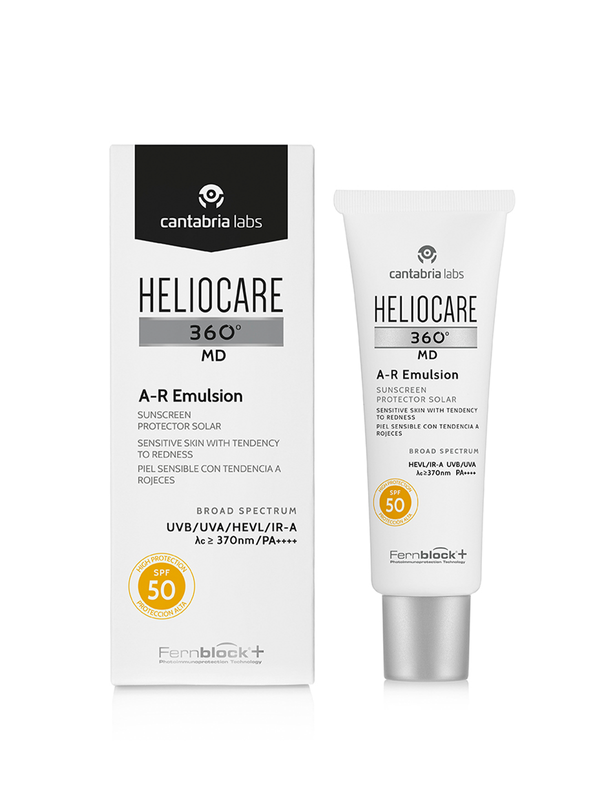What is rosacea and why does sun protection matter?
Rosacea is a very common skin condition, estimated to affect one in five of us. Most instances of permanent skin redness are a manifestation of rosacea. But some people also experience milder cases of redness.
Sun exposure is one of the main triggers of rosacea and redness, which is why high-level daily protection is so important, especially as we head into the warmer seasons. But why are some people more likely to experience rosacea symptoms? And how can we prevent flare-ups? We explain everything below.
Who experiences rosacea symptoms?
Rosacea is more common in women; however, men are more likely to experience severe cases of rosacea1. It is also more noticeable in lighter skin types because there is less pigment (melanin) to conceal the redness. Rosacea typically affects the face, neck, and chest area.
Environmental factors play a major role in triggering rosacea; however, genetics determine whether a person will experience rosacea symptoms. Researchers are yet to discover which gene is the root cause of rosacea, but it is anticipated that a combination of skin cell function, blood supply and immune response is what determines if we experience rosacea or not.
What are the symptoms of rosacea?
The most common symptom is a flushed red complexion, but people may also experience swelling, enlarged blood vessels, skin thickening and breakouts. Around half of those who experience rosacea will also experience eye problems such as itchiness, dryness and sensitivity to light.
During a rosacea flare up, people experience vasodilation2, where their blood vessels become wider, or inflammation, when the immune system sends inflammatory cells to attack a suspected threat.
The physical symptoms of rosacea can be mild to severe, but we also need to consider the impact it has on our emotional and mental health. Many report feelings of low confidence and low self-esteem, as well as embarrassment, which further exacerbates redness and creates a vicious cycle. From a sensory perspective, rosacea can also be uncomfortable and itchy, and it can be tricky to identify products that work well without irritation.
Rosacea triggers
Common triggers for rosacea and redness include sunlight, exercise, stress and anxiety. People may also react to inflammatory food and drink, including alcohol, spices, sugar and hot caffeinated drinks. The weather also has an impact, especially wind, dry air and the heat of the summer.
How does the sun affect rosacea?
Sun exposure is especially aggravating for redness-prone skin and ranks as the most common cause of a rosacea flare-up3. It is particularly troublesome in the spring and summer months, when UVB rays are stronger and temperatures and humidity levels are higher. This combination of environmental factors makes flare-ups more likely.
UV light has been found to be implicated in the main rosacea symptoms, including skin inflammation, spider veins and skin thickening4. UV radiation also reduces the skin’s natural production of collagen and elastin, which weakens the structure and hinders drainage5.
Just a few moments of heat and light from the sun can cause uncontrollable redness. Furthermore, the build-up of sun damage over the years makes the skin less resilient against bouts of rosacea, thus worsening symptoms. That’s why people who experience rosacea and redness must be extra vigilant during the summer months.
How to prevent and treat rosacea
One of the most effective ways to avoid a rosacea flare-up is to avoid your known triggers as much as possible, whether that’s intense exercise, caffeine, or stressful situations. Often, this is easier said than done!
When it’s cold and windy outside, shield your face with a light scarf, avoiding rough fabrics. When it’s warm and sunny, always remember to wear sun protection, a wide brimmed hat and protective clothing.
In mild to moderate cases of rosacea, creams or gels can be prescribed by the doctor to help constrict blood vessels. Other topical products can also help to reduce breakouts. In severe cases, antibiotics may be prescribed, such as oral acne medications to clear up lesions. Laser therapy can also be a very effective treatment, making large blood vessels less visible.
A good regular skin care regime is essential when managing skin redness and rosacea. Try gentle products that won’t lead to stinging or burning. Focus on hydrating the skin and strengthening the skin barrier. And of course, always apply high-level, broad-spectrum sun protection as the final step in your routine, the ultimate way to show your skin some love and protect its health for the long-term.
Heliocare 360° A-R Emulsion
Sun exposure plays a major role in the onset of skin redness and long-term symptoms, so an advanced, broad-spectrum sun protection product is the cornerstone of managing rosacea. That’s where Heliocare 360° A-R Emulsion comes in.
The A-R Emulsion from Heliocare 360° is scientifically designed for skin that’s prone to redness and sensitivity. With an innovative anti-redness system, it provides three levels of action to protect, correct and prevent redness. The silky and nourishing fluid feels beautiful on the skin and, most importantly, provides the highest levels of protection against the full spectrum of light, including UVA, UVB, visible light and infrared-A.
Heliocare 360° A-R Emulsion contains four powerful components: Physavie, which helps calm the skin; Rosabora, which helps soothe and reduce redness; Glutation, a powerful anti-oxidant that helps restore and protect the skin’s barrier, and finally Fernblock, a patented plant extract that is clinically proven to prevent and repair sun damage. Each powerful ingredient targets and regulates certain factors in the onset of rosacea, including controlling skin temperature, decreasing the appearance of blood vessels, stimulating the immune response and preventing the inflammatory cascade. Fernblock also helps to protect skin cell DNA, neutralise free radicals and prevent collagen breakdown, which further boosts skin health and youthfulness.
What’s more, our A-R Emulsion contains a light pigment that helps to unify the skin tone and blurs blemishes, creating a smoother and more evenly toned complexion instantly.
Heliocare 360° A-R Emulsion is ideal for use all year round, even when the skin is feeling particularly sensitive. After using the product, 89% of those surveyed reported reduced irritation, reduced number breakouts and better self-confidence. 94% of users also said the product reduced skin redness6.
Shop Heliocare 360° A-R Emulsion - the perfect daily sunscreen for sensitive, redness and rosacea prone skin.
In the article

- For sensitive skin prone to redness
- Suitable for Fitzpatrick skin types I-IV
- SPF50 & PA++++
- Reduces redness and soothes the skin
References:
1 www.aad.org. (n.d.). Rosacea: Who gets and causes. [online] Available at: https://www.aad.org/public/diseases/rosacea/what-is/causes.
2 Weiss, E. and Katta, R. (2017). Diet and rosacea: the role of dietary change in the management of rosacea. Dermatology Practical & Conceptual, 7(4), pp.31–37. doi:https://doi.org/10.5826/dpc.0704a08.
3 sun | Rosacea.org. (n.d.). Retrieved March 7, 2023, from www.rosacea.org website: https://www.rosacea.org/tags/sun
4 Morgado‐Carrasco, D., Granger, C., Trullas, C. and Piquero‐Casals, J. (2021). Impact of ultraviolet radiation and exposome on rosacea: Key role of photoprotection in optimizing treatment. Journal of Cosmetic Dermatology. doi:https://doi.org/10.1111/jocd.14020.
5 Jay, R. and Rodger, J. (2022). Resolution of Rosacea-Associated Persistent Facial Edema with Osteopathic Manipulative Treatment. JAAD Case Reports. doi:https://doi.org/10.1016/j.jdcr.2022.07.014.
6 Trial conducted on 21 adult women (18-65 years of age). 50% with sensitive skin and 50% with rosacea. The organoleptic and physiochemical characteristics and subjective efficacy of the product were evaluated after 28 days use.






